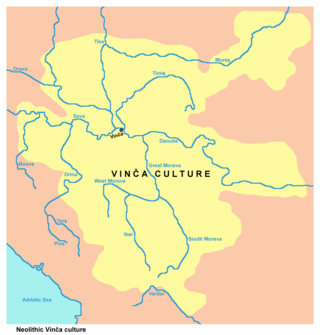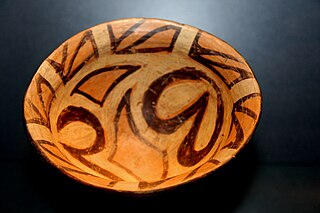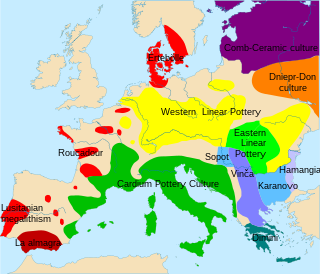
Marija Gimbutas was a Lithuanian archaeologist and anthropologist known for her research into the Neolithic and Bronze Age cultures of "Old Europe" and for her Kurgan hypothesis, which located the Proto-Indo-European homeland in the Pontic Steppe.

A mother goddess is a major goddess characterized as a mother or progenitor, either as an embodiment of motherhood and fertility or fulfilling the cosmological role of a creator- and/or destroyer-figure, typically associated the Earth, sky, and/or the life-giving bounties thereof in a maternal relation with humanity or other gods. When equated in this lattermost function with the earth or the natural world, such goddesses are sometimes referred to as the Mother Earth or Earth Mother, deity in various animistic or pantheistic religions. The earth goddess is archetypally the wife or feminine counterpart of the Sky Father or Father Heaven, particularly in theologies derived from the Proto-Indo-European sphere. In some polytheistic cultures, such as the Ancient Egyptian religion which narrates the cosmic egg myth, the sky is instead seen as the Heavenly Mother or Sky Mother as in Nut and Hathor, and the earth god is regarded as the male, paternal, and terrestrial partner, as in Osiris or Geb who hatched out of the maternal cosmic egg.

The Tărtăria tablets are three tablets, reportedly discovered in 1961 at a Neolithic site in the village of Tărtăria in Săliștea commune, from Transylvania.

The Vinča symbols or Vinča–Turdaș signs, Old European script, Danube script are a set of untranslated symbols found on Neolithic era artifacts from the Vinča culture and other related "Old European" cultures of Central and Southeastern Europe. Whether this is one of the earliest writing systems or simply symbols of some sort is disputed. They have sometimes been described as an example of proto-writing. The symbols went out of use around 3,500 BC.

The Vinča culture (ʋîːntʃa), also known as Turdaș culture, Turdaș–Vinča culture or Vinča-Turdaș culture, is a Neolithic archaeological culture of Southeast Europe, dated to the period 5400–4500 BC. Named for its type site, Vinča-Belo Brdo, a large tell settlement discovered by Serbian archaeologist Miloje Vasić in 1908, it represents the material remains of a prehistoric society mainly distinguished by its settlement pattern and ritual behaviour.
Old Europe is a term coined by the Lithuanian archaeologist Marija Gimbutas to describe what she perceived as a relatively homogeneous pre-Indo-European Neolithic and Copper Age culture or civilisation in Southeast Europe, centred in the Lower Danube Valley. Old Europe is also referred to in some literature as the Danube civilisation.

The Kurgan hypothesis is the most widely accepted proposal to identify the Proto-Indo-European homeland from which the Indo-European languages spread out throughout Europe and parts of Asia. It postulates that the people of a Kurgan culture in the Pontic steppe north of the Black Sea were the most likely speakers of the Proto-Indo-European language (PIE). The term is derived from the Turkic word kurgan (курга́н), meaning tumulus or burial mound.
Sesklo is a village in Greece that is located near Volos, a city located within the municipality of Aisonia. The municipality is located within the regional unit of Magnesia that is located within the administrative region of Thessaly. During the prehistory of Southeastern Europe, Sesklo was a significant settlement of Neolithic Greece, before the advent of the Bronze Age and millennia before the Mycenaean period.

The Cucuteni–Trypillia culture, also known as the Cucuteni culture or the Trypillia culture, is a Neolithic–Chalcolithic archaeological culture of Southeast Europe. It extended from the Carpathian Mountains to the Dniester and Dnieper regions, centered on modern-day Moldova and covering substantial parts of western Ukraine and northeastern Romania, encompassing an area of 350,000 km2 (140,000 sq mi), with a diameter of 500 km.

The Lengyel culture is an archaeological culture of the European Neolithic, centered on the Middle Danube in Central Europe. It flourished from 5000 to 4000 BC, ending with phase IV, e.g., in Bohemia represented by the 'Jordanow/Jordansmühler culture'. It is followed by the Funnelbeaker culture/TrB culture and the Baden culture. The eponymous type site is at Lengyel in Tolna county, Hungary.

The Globular Amphora culture (GAC, German: Kugelamphoren-Kultur ; c. 3400–2800 BC, is an archaeological culture in Central Europe. Marija Gimbutas assumed an Indo-European origin, though this is contradicted by newer genetic studies that show a connection to the earlier wave of Early European Farmers rather than to Western Steppe Herders from the Ukrainian and south-western Russian steppes.

A matriarchal religion is a religion that emphasizes a goddess or multiple goddesses as central figures of worship and spiritual authority. The term is most often used to refer to theories of prehistoric matriarchal religions that were proposed by scholars such as Johann Jakob Bachofen, Jane Ellen Harrison, and Marija Gimbutas, and later popularized by second-wave feminism. These scholars speculated that early human societies may have been organized around female deities and matrilineal social structures. In the 20th century, a movement to revive these practices resulted in the Goddess movement.
Shypyntsi, a village in Ukraine, is located within Chernivtsi Raion (district) of Chernivtsi Oblast (province), about 530 kilometers (330 mi) driving distance southwest of Kyiv, and about 30 kilometers (19 mi) northwest from the provincial capital of Chernivtsi. Shypyntsi is about 48 kilometers (30 mi) from the Ukrainian/Romanian border, about 64 kilometers (40 mi) from the Ukrainian/Moldovan border, and about 80 kilometers (50 mi) from the city of Suceava, Romania. Boxing champion Oleksander Usyk is from this village, which is located on the left bank of the Prut River, amid rolling hills covered with farms and forests, in the region generally known as the Dniester Hills. It belongs to Kitsman urban hromada, one of the hromadas of Ukraine.

The study of the religion and ritual of the Cucuteni-Trypillia culture has provided important insights into the early history of Europe. The Cucuteni–Trypillia culture inhabited the present-day southeastern European nations of Moldova, Romania, and Ukraine during the Neolithic and Copper Ages. It left behind many settlement ruins that contain archaeological artifacts attesting to their cultural and technological characteristics.

Due partly to the fact that this took place before the written record of this region began, there have been a number of theories presented over the years to fill the gap of knowledge about how and why the end of the Cucuteni–Trypillia culture happened. These theories include invasions from various groups of people, a gradual cultural shift as more advanced societies settled in their region, and environmental collapse.

The Gumelniţa culture was a Chalcolithic culture of the 5th millennium BC, named after the Gumelniţa site on the left (Romanian) bank of the Danube.
The Tisza culture is a Neolithic archaeological culture of the Alföld plain in modern-day Hungary, Western Romania, Eastern Slovakia, and Ukrainian Zakarpattia Oblast in Central Europe. The culture is dated to between 5400 BCE and 4500/4400 BCE.

The Linear Pottery culture (LBK) is a major archaeological horizon of the European Neolithic period, flourishing c. 5500–4500 BC. Derived from the German Linearbandkeramik, it is also known as the Linear Band Ware, Linear Ware, Linear Ceramics or Incised Ware culture, falling within the Danubian I culture of V. Gordon Childe.

The Chalice and The Blade: Our History, Our Future is a 1987 book by Riane Eisler. The author presents a conceptual framework for studying social systems with particular attention to how a society constructs roles and relations between the female and male halves of humanity.
Parța Neolithic Sanctuary refers to an excavated Neolithic cult-centre or shrine located on the right bank of the Timiș River at Parța, south of Timișoara, in Romania.













